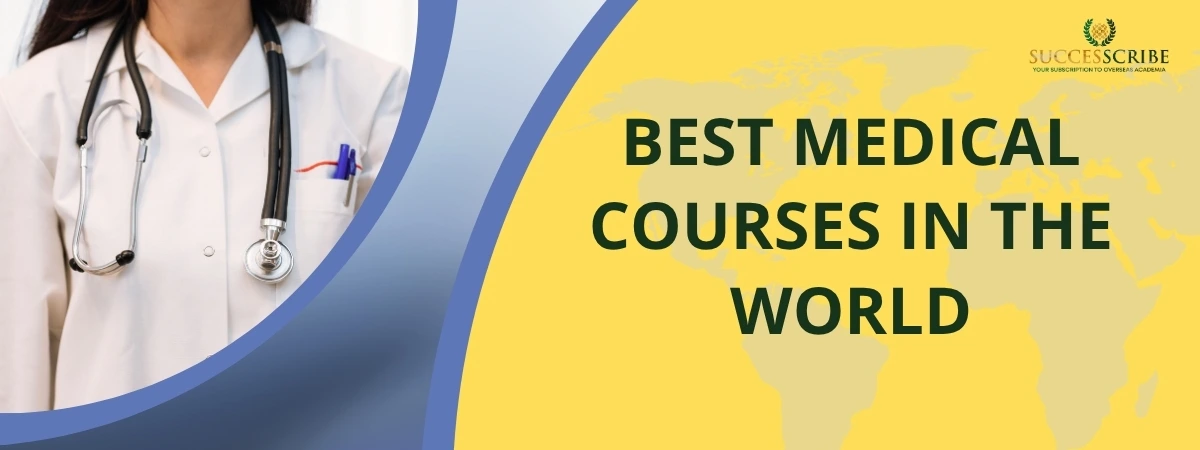Medicine remains one of the most respected, intellectually challenging, and globally impactful fields in human history. As the world enters 2025–26, the significance of medical education has advanced far beyond traditional degrees. From high-end clinical programs like MBBS and MD to modern disciplines such as Biomedical Engineering, Genomics, Clinical Research, Medical Imaging, Public Health, and Neuropsychology, the scope of medical learning has expanded rapidly. The next decade is expected to reshape global healthcare entirely. With technological innovation, the explosion of chronic diseases, new viral outbreaks, aging populations, and rapidly urbanizing societies, the demand for skilled medical professionals has reached record levels.
The Best Medical Courses in the World are shaping the future of global healthcare by combining advanced clinical training, cutting-edge research, and modern technology. This is exactly why medical courses today are not just academic programs – they are long-term career investments that guarantee global employability.
Key Highlights – Best Medical Courses in the World
- Why Medical Courses are Globally Significant
- Global Demand for Healthcare Professionals
- Top 10 Medical Courses in the World (Clinical & Technical Programs)
- Which Medical Course Has the Highest Salary in the World?
- Easiest vs. Hardest Medical Courses in the World
- Admission Requirements for the Best Medical Courses in the World
- Conclusion
Want to Study in Europe?
Start your journey with Successcribe’s free expert guidance
Book a Free Session NowWhy Medical Courses Are Globally Significant
The Most Preferred Medical Courses in the World are in high demand because rising chronic diseases, aging populations, and rapid technological innovation require highly skilled medical professionals. Here are some reasons why they are significant:
1. Rising Disease Burden
According to the World Health Organization (WHO), chronic diseases like cardiovascular disorders, cancer, diabetes, and respiratory illnesses contribute to 74% of global deaths as of 2024. This will rise further by 2030, creating a massive need for doctors, nurses, and specialized technicians.
2. Aging Population Across the World
Countries like Japan, Germany, Italy, Canada, South Korea, and the UK are entering a demographic transformation where the 65+ population is expanding rapidly. The UN projects that by 2030, 1 in 6 people globally will be over 60.
This increases the need for geriatrics, oncology, physiotherapy, nursing, and chronic disease specialists.
3. Advances in Medical Technology
The medical field is experiencing a revolution in:
- AI diagnostics
- Robotic surgery
- Stem cell therapy
- Organ bio-printing
- Genetic & genomic medicine
- Telemedicine
- Medical imaging systems
These advancements require new types of trained professionals, making medical courses more diverse and future-ready.
4. Globalization of Medical Education
Countries like the USA, UK, Australia, Germany, Singapore, India, Ireland, South Korea, and the UAE have become leading destinations for medical students due to:
- Top-ranked universities
- Excellent clinical exposure
- High-end labs
- Scholarships and work opportunities
- Better doctor-to-population ratios
Medical degrees are more mobile than ever: professionals trained in one country can apply for licensure or specializations in another.
Related Post: Cost of MBBS in USA for Indian students
Global Demand for Healthcare Professionals
The world is facing a historic healthcare workforce shortage, making medical courses extremely valuable. Due to the worldwide shortage of skilled professionals, the Best Medical Courses in the World offer exceptional career growth and international job opportunities.
1. WHO Healthcare Workforce Gap
WHO estimates a shortage of 10 million healthcare workers by 2030, especially in:
- Low-income nations
- African region
- South-East Asia
- Gulf countries
- Rural Europe
- American health systems
But even developed nations face shortages.
2. OECD Data (2024–25)
According to OECD:
- The demand for specialists such as radiologists, anesthesiologists, and surgeons will grow by 25 – 40% by 2030.
- The global nurse population must increase by 20 million by 2027.
- Around 30% of practicing doctors in OECD nations will retire by 2035, creating urgent vacancies.
3. Country-Specific Job Projections (2025–26)
| Country | Projected Job Growth in Healthcare (2025–30) | Key Demand Areas |
| USA | +2.6 million jobs | Nursing, surgery, radiology, public health |
| UK | +1.2 million jobs | GPs, nursing, pharmacy |
| Australia | +250,000 jobs | Aged care, physiotherapy, diagnostics |
| Canada | +230,000 jobs | Psychiatry, nursing, medical imaging |
| Germany | +400,000 jobs | Nursing, physicians, lab technicians |
These numbers make it clear that medical degrees guarantee strong career outcomes globally.
Top 10 Medical Courses in the World (Clinical & Technical Programs)
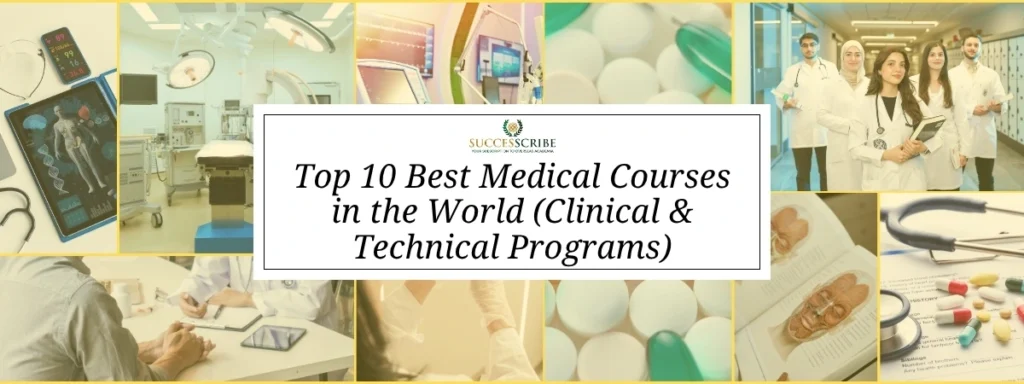
We explore the most in-demand medical courses globally, duration, skills, fees, universities, salaries, and job demand statistics. Many of the best MBBS colleges in world collaborate with leading hospitals to provide real-world experience from the first year itself.
1. MBBS / MD (Bachelor of Medicine & Bachelor of Surgery / Doctor of Medicine)
MBBS (UK, India, Asia) or MD (USA, Canada) continues to be the most prestigious and in-demand medical course globally.
What the Course Is
A professional degree that trains students in:
- Anatomy
- Physiology
- Surgery
- Pharmacology
- Pediatrics
- Internal Medicine
Clinical practices and hospital rotations
Skills Gained
- Diagnostic skills
- Surgical and clinical decision-making
- Patient management
- Emergency care
- Research & analytical skills
Duration
| Country | Duration |
| India | 5.5 years |
| UK | 5–6 years |
| USA (MD) | 4 years + 3–7 years residency |
| Australia | 5–6 years |
| Germany | 6 years |
Top Countries
USA, UK, Germany, Australia, Canada, Singapore
Top Universities
- Harvard University
- University of Oxford
- Johns Hopkins University
- University of Cambridge
- Stanford University
- Karolinska Institute
- University of Toronto
Average Tuition Fee
- USA: $45,000 – $75,000/year
- UK: £35,000 – £55,000/year
- Germany: €0 – €3,000/year (public universities)
- Australia: AUD 60,000/year
Career & Global Salary
- General Physician: $140,000 – $220,000/year
- Surgeon: $250,000 – $500,000/year
- Cardiologist: $350,000 – $700,000/year
- Neurologist: $200,000 – $450,000/year
Job Demand
WHO reports a shortage of 2.4 million physicians globally by 2030. The USA alone needs 124,000 doctors by 2033.
Related Post: MBBS in Germany for Indian students
2. BDS / DDS (Bachelor of Dental Surgery / Doctor of Dental Surgery)
Dentistry remains one of the highest-paying and most stable medical professions.
What the Course Is
Training in oral health, dental surgery, orthodontics, prosthodontics, and dental diagnostics.
Skills Gained
- Dental surgery
- Cosmetic dentistry
- Orthodontics
- Patient diagnostics
- Prosthetics
Duration
| Country | Duration |
| India | 5 years |
| UK | 5 years |
| USA (DDS) | 4 years |
| Australia | 5 years |
Top Universities
- University of Michigan
- King’s College London
- Tokyo Medical Dental University
- Harvard School of Dental Medicine
Average Tuition Fee
- USA: $50,000 – $80,000/year
- UK: £35,000 – £50,000/year
Career & Global Salary
- General Dentist: $150,000 – $250,000/year
- Orthodontist: $280,000 – $450,000/year
- Oral Surgeon: $300,000 – $600,000/year
Job Demand
OECD reports a 25% global rise in demand for dental professionals due to aging populations.
3. Nursing (BSc Nursing / MSN / Nurse Practitioner)
Nursing is the fastest-growing medical profession worldwide.
What the Course Is
Focuses on patient care, emergency care, pharmacology, anatomy, and clinical nursing practice.
Skills Gained
- Clinical care
- Emergency support
- Patient management
- ICU & surgical assistance
- Leadership (MSN, NP programs)
Duration
| Country | BSc Nursing | MSN |
| USA | 4 years | 2 years |
| UK | 3 years | 1–2 years |
| Australia | 3 years | 1.5 years |
| Canada | 4 years | 2 years |
Top Universities
- University of Pennsylvania
- Johns Hopkins University
- University of Toronto
- King’s College London
Average Tuition Fee
- BSc Nursing: $25,000 – $45,000/year
- MSN: $40,000 – $60,000/year
Salary
- Registered Nurse: $70,000 – $120,000/year
- Nurse Practitioner: $120,000 – $160,000/year
Job Demand
WHO estimates a shortage of 6 million nurses globally by 2030.
Related Post: Bachelor of Nursing in Germany
4. Pharmacy (B.Pharm / PharmD / M.Pharm)
Pharmacy is essential due to the growing pharmaceutical and biotechnology sectors.
What the Course Is
Covers drug design, drug action, clinical pharmacy, pharmacology, and research.
Skills Gained
- Drug formulation
- Patient counseling
- Pharmaceutical research
- Lab techniques
Duration
| Program | Duration |
| B.Pharm | 4 years |
| PharmD | 6 years |
| M.Pharm | 2 years |
Top Universities
- University of California, San Francisco
- Monash University
- Harvard University
- University of Oxford
Average Tuition Fee
$20,000 – $55,000/year
Salary
- Clinical Pharmacist: $90,000 – $150,000/year
- Research Scientist: $110,000 – $200,000/year
Job Demand
Global pharma industry projected to reach $1.8 trillion by 2027, boosting pharmacy careers.
Related Post: Masters in Pharmacy in Germany
5. Biomedical Engineering (BME)
A futuristic course connecting engineering with medicine.
What the Course Is
Focuses on designing medical devices, robotics, prosthetics, imaging systems, and AI-based healthcare solutions.
Skills Gained
- Robotics in healthcare
- Medical imaging
- AI diagnostics
- Device design
- Biomechanics
Duration
| Country | Duration |
| USA | 4 years |
| UK | 3 years |
| Australia | 4 years |
| India | 4 years |
Top Universities
- MIT
- Stanford University
- Georgia Tech
- Imperial College London
Average Tuition Fee
$30,000 – $60,000/year
Salary
- Biomedical Engineer: $80,000 – $140,000/year
- AI-Healthcare Engineer: $120,000 – $200,000/year
Job Demand
Global biomedical device market projected to reach $950 billion by 2030.
Related Post: Masters in Biomedical Engineering in Germany
6. Biotechnology (BSc / MSc Biotechnology)
Biotechnology has become one of the world’s fastest-growing medical science fields due to advancements in genomics, vaccines, molecular biology, and regenerative medicine.
What the Course Is
Biotechnology combines biology, chemistry, technology, and engineering to create medical and biological solutions – vaccines, drugs, genetic therapy, stem cell innovations, and diagnostics.
Skills Gained
- Molecular biology
- Genetic engineering
- CRISPR gene editing
- Vaccine design
- Tissue culture
- Biostatistics & bioinformatics
Duration
| Country | Duration |
| USA | 4 years (BSc), 2 years (MSc) |
| UK | 3 years (BSc), 1 year (MSc) |
| Germany | 3 years (BSc), 2 years (MSc) |
| India | 3–4 years (BSc), 2 years (MSc) |
Top Universities
- MIT
- Stanford University
- ETH Zurich
- University of Cambridge
- Johns Hopkins University
- National University of Singapore
Average Tuition Fee
$25,000 – $60,000/year
Career Opportunities & Salary
- Biotechnologist: $70,000 – $150,000/year
- Genetic Engineer: $110,000 – $220,000/year
- Biomedical Scientist: $100,000 – $180,000/year
- Research Scientist (Pharma): $120,000 – $200,000/year
Job Demand
Global biotechnology industry expected to reach $3.6 trillion by 2030, with high demand for genomics and therapeutic specialists.
7. Physiotherapy (BPT / MPT)
Physiotherapy has gained tremendous relevance due to aging populations, sports medicine growth, and rising musculoskeletal disorders.
What the Course Is
Focuses on rehabilitation, injury recovery, exercise therapy, musculoskeletal health, neurology, and sports therapy.
Skills Gained
- Physical rehabilitation
- Orthopedic therapy
- Neurological physiotherapy
- Exercise science
- Sports medicine
Duration
| Country | Duration |
| India | 4.5 years |
| UK | 3 years |
| Australia | 4 years |
| Canada | 4 years |
Top Universities
- University of Toronto
- King’s College London
- University of Melbourne
- University of Sydney
Average Tuition Fee
$20,000 – $45,000/year
Career & Salary
- Physiotherapist: $60,000 – $110,000/year
- Sports Therapist: $80,000 – $150,000/year
- Neuro-physiotherapist: $90,000 – $140,000/year
Job Demand
WHO reports increasing demand due to global rise in chronic orthopedic disorders.
8. Public Health (MPH)
Public Health is one of the most critical medical courses for global disease control, policymaking, epidemiology, and healthcare leadership.
What the Course Is
Training in disease prevention, epidemiology, health policy, data analysis, biostatistics, and global health systems.
Skills Gained
- Epidemiological analysis
- Health policy development
- Data-driven decision-making
- Disease surveillance
- Leadership in public health
Duration
| Country | Duration |
| USA | 2 years |
| UK | 1 year |
| Australia | 1.5–2 years |
| Canada | 2 years |
Top Universities
- Harvard School of Public Health
- Johns Hopkins Bloomberg School
- University of Washington
- University of London
Average Tuition Fee
$30,000 – $70,000/year
Career & Salary
- Epidemiologist: $80,000 – $140,000/year
- Public Health Officer: $60,000 – $120,000/year
- Health Policy Analyst: $80,000 – $150,000/year
- WHO/UN roles: $100,000 – $200,000/year
Job Demand
COVID-19 expanded the global public health workforce by 70% and continues to grow.
Related Post: Masters in Public Health in Germany
9. Psychology & Psychiatry
Mental health care is one of the fastest-growing medical fields due to global stress, anxiety, depression, and neurological disorders.
What the Course Is
Psychology (BSc/MSc) focuses on behavioral science. Psychiatry (MD) focuses on diagnosis and treatment of mental disorders.
Skills Gained
- Clinical diagnosis
- Counseling
- Behavioral therapy
- Psychotherapy
- Neuropsychology
Duration
| Course | Duration |
| BSc Psychology | 3–4 years |
| MSc Psychology | 1–2 years |
| MD Psychiatry | 4 years + residency |
Top Universities
- Stanford University
- University of Oxford
- Harvard University
- UCL
Average Tuition Fee
$25,000 – $55,000/year
Career & Salary
- Clinical Psychologist: $80,000 – $140,000/year
- Psychiatrist: $200,000 – $350,000/year
Job Demand
WHO reports a 25% increase in global mental health cases since 2020.
10. Veterinary Medicine (DVM)
Veterinary medicine is essential for animal healthcare, zoonotic disease control, and public health.
What the Course Is
Covers animal surgery, medicine, pathology, parasitology, and zoonotic diseases.
Skills Gained
- Animal surgery
- Animal pathology
- Diagnostics
- Zoonotic disease control
Duration
| Country | Duration |
| USA | 4 years |
| UK | 5 – 6 years |
| Australia | 5 years |
| India | 5.5 years |
Top Universities
- UC Davis
- Cornell University
- University of Guelph
- University of Sydney
Average Tuition
$30,000 – $60,000/year
Salary
DVM professionals earn $90,000 – $180,000/year globally.
Apply to Top European Universities
Make your application simple and stress-free with Successcribe
Get Expert Help NowWhich Medical Course Has the Highest Salary in the World?
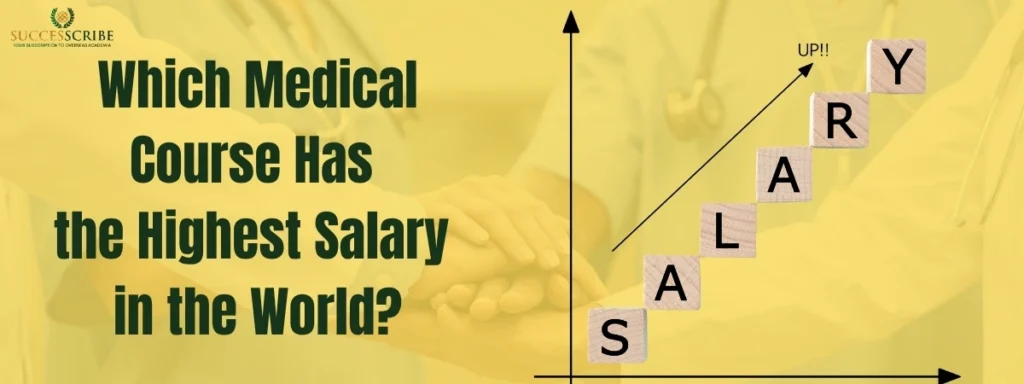
Many of the highest-paying medical fields—like neurosurgery, cardiology, and dermatology—originate from the Best Medical Courses in the World. While all medical fields offer financial stability, the pinnacle of earning potential lies within highly specialized surgical and medical disciplines, typically requiring an MD (or equivalent) followed by extensive residency and fellowship training (often 10-15 years post-graduation).
Based on 2025 – 26 compensation data from sources like Medscape’s Physician Compensation Report and international recruitment agencies, the highest earners are:
Top Highest Paying Medical Careers
| Medical Career | Average Annual Salary (USA) | UK | Germany | Australia | UAE |
| Neurosurgeon | $520,000–$850,000 | £350,000 | €300,000 | AUD 550,000 | AED 1M+ |
| Orthopedic Surgeon | $500,000–$750,000 | £320,000 | €280,000 | AUD 500,000 | AED 800,000+ |
| Cardiologist | $450,000–$650,000 | £250,000 | €260,000 | AUD 450,000 | AED 700,000+ |
| Dermatologist | $300,000–$480,000 | £180,000 | €160,000 | AUD 350,000 | AED 600,000+ |
| Radiologist | $350,000–$500,000 | £160,000 | €150,000 | AUD 300,000 | AED 550,000+ |
| Anesthesiologist | $400,000–$600,000 | £200,000 | €180,000 | AUD 360,000 | AED 650,000+ |
| Psychiatrist | $250,000–$420,000 | £150,000 | €140,000 | AUD 280,000 | AED 500,000+ |
| Dentist / Oral Surgeon | $200,000–$450,000 | £120,000 | €100,000 | AUD 250,000 | AED 450,000+ |
| Pharmacist | $120,000–$150,000 | £45,000 | €60,000 | AUD 100,000 | AED 200,000 |
| Nurse Practitioner (NP) | $120,000–$160,000 | £55,000 | €50,000 | AUD 120,000 | AED 180,000 |
It is crucial to remember that these figures are predominantly from the US healthcare system. Salaries in socialized medicine systems like the UK’s NHS or in Australia, while still very high, are generally lower and capped within public sector pay scales.
Easiest vs. Hardest Medical Courses in the World
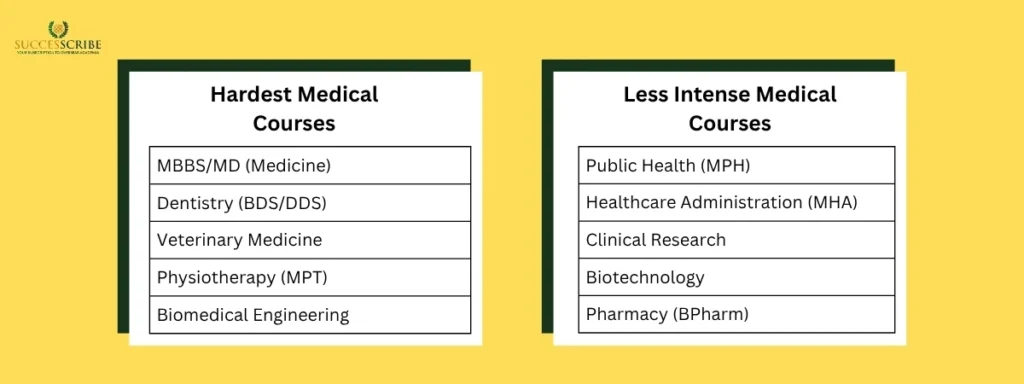
“Easy” and “hard” are subjective, but we can measure them by acceptance rates, academic rigor, and the emotional and physical demands of the profession. Choosing from the best MBBS colleges in world can significantly impact your medical career and specialization options.
Hardest Medical Courses (Based on Competition & Rigor):
| Course | Global Acceptance Rate | Why It’s Hard |
| MBBS/MD (Medicine) | 2%–10% | Tough entrance exams, long duration, high competition |
| Dentistry (BDS/DDS) | 5%–12% | High score requirements, manual dexterity tests |
| Veterinary Medicine | 10% | Fewer seats, extensive training |
| Physiotherapy (MPT) | 8–15% | Strong practical component |
| Biomedical Engineering | 10–20% | Strong maths + medical science combination |
Reasons These Courses Are Hard
- Long duration (5–10 years)
- Strict licensing exams
- Complex subjects like anatomy, neurology, surgery
- Competitive admissions
Less Intense Medical Courses
| Course | Acceptance Rate | Why It’s Easier |
| Public Health (MPH) | 40–60% | Accepts non-medical background students |
| Healthcare Administration (MHA) | 50–70% | No heavy science subjects |
| Clinical Research | 35–50% | Research-focused, not clinical |
| Biotechnology | 30–50% | Theory-heavy, less competition |
| Pharmacy (BPharm) | 30–45% | Broad availability of colleges |
Reasons These Courses Are Easier
- Lower competition
- Shorter course duration
- No surgical or intense clinical training
- More theory and research-oriented
Admission Requirements for the Best Medical Courses in the World
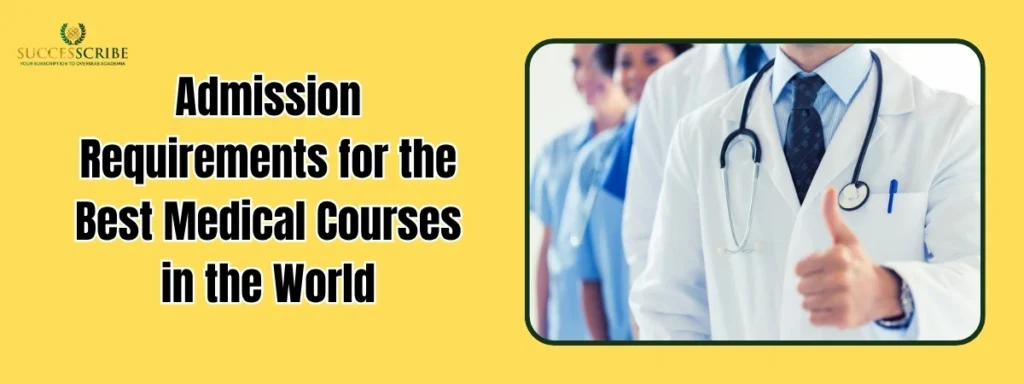
Getting into a top medical course – whether MBBS, Nursing, Pharmacy, or Biomedical programs – requires strong academics, language skills, and standardized tests. Below is a clear, easy-to-understand breakdown of the requirements.
1. Academic Eligibility
Most medical programs in 2025–26 require strong academic performance in science subjects.
For Bachelor’s Courses (MBBS, BDS, BSc Nursing, BPT, Pharmacy, Biotech):
- Completed 12th Grade / High School
- Mandatory Subjects: Biology, Chemistry, Physics (some countries accept Maths for Engineering-based programs)
Minimum Marks:
- USA: GPA 3.0–3.8
- UK: A-Levels (AAA–ABB)
- Germany: 90%+ for MBBS/medicine
- Australia/Canada: 70%–85%
- Age Requirement: 17+ for medicine-related bachelor’s degrees
For Master’s Courses (MPH, MHA, MSc Biotechnology, MPharm, Physiotherapy, Clinical Research):
- Bachelor’s degree in a relevant field
- Minimum overall GPA: 2.75–3.2
- Some programs require professional experience (especially MHA & MPH)
2. Entrance Exams
Different countries require different entrance exams depending on the program.
- MCAT (USA) – Required for MBBS/MD
- UCAT / BMAT (UK) – Medicine & Dentistry
- NEET (India) – MBBS, BDS, Nursing, etc.
- GAMSAT (Australia) – Graduate-entry medicine
- HPAT (Ireland) – Medicine
- German Studienkolleg / Feststellungsprüfung – For international MBBS aspirants
- GRE/GMAT – Required for some postgraduate healthcare programs (MPH/MHA)
3. English Proficiency Requirements
If studying in an English-speaking country, students must show English language ability.
Accepted Tests (Minimum Scores):
- IELTS: 6.0–7.5
- TOEFL iBT: 80–100+
4. Supporting Documents
Almost every medical course requires the following:
- Passport
- Academic Transcripts
- Letters of Recommendation (LORs) – Usually 2–3
- Statement of Purpose (SOP) or Personal Statement
- CV/Resume
- Proof of Funds (for visa and university)
- Medical Fitness Certificate
- Work Experience Certificates (for MPH, MHA, MSN, etc.)
5. Additional Country-Specific Requirements
USA
- MCAT compulsory
- CASPer situational judgment test for many universities
- Background check for clinical rotations
UK
- UCAT/BMAT required
- Multiple Mini Interviews (MMI)
- Vaccination records needed
Germany
- Very high academic scores (90%–97%)
- German language proficiency (B2–C1) for many programs
- APS Certificate for Indian students
- Studienkolleg for non-EU students
Australia
- GAMSAT (graduate entry)
- Interview + Situational test
- Proof of immunization
Canada
- IELTS 7.0
- CASPer test
- High school Biology & Chemistry mandatory
Conclusion
Medicine remains one of the most rewarding and future-proof career paths in 2025–26. With rising global health challenges, aging populations, and WHO’s projected shortage of 10 million healthcare workers by 2030, the demand for skilled medical professionals is stronger than ever. At the same time, rapid advancements in AI, robotics, biotechnology, genomics, and medical imaging are reshaping the future of healthcare and creating exciting opportunities across both clinical and non-clinical fields. The Best Medical Courses in the World open doors to global careers, high salaries, and long-term job security across every major healthcare industry. The best MBBS colleges in world are known for their strong research output and high student success rates.
With the right dedication and training, a career in healthcare will not only provide stability and growth but also allow you to play a meaningful role in improving lives around the world.
FAQs
Which is the best medical course in the world?
The MBBS/MD (Bachelor of Medicine and Surgery) is considered the best medical course globally due to its strong career prospects, worldwide recognition, and high demand for doctors. Specializations like Cardiology, Orthopedics, Neurosurgery, and Dermatology are among the top choices.
Which medical course has the highest salary in 2025–26?
Neurosurgery currently offers the highest salaries in the medical field, with professionals earning between $500,000–$850,000 per year in top countries. Orthopedic surgeons, cardiologists, radiologists, and anesthesiologists also rank among the highest-paid.
Which country is best for studying medical courses?
The top countries for medical education include:
USA – Best for advanced specializations
UK – High-quality medical programs
Canada – Great for public health & nursing
Germany – Low-cost or free medical education
Australia – High job placement rates
What are the cheapest countries to study medical courses in 2025–26?
The most affordable countries are:
1. Germany (Public universities are tuition-free)
2. Italy
3. Poland
4. Kazakhstan
5. Philippines
6. Russia
These countries offer globally recognized MBBS and allied health programs at low tuition fees.
What is the duration of medical courses worldwide?
Duration varies by country and course:
MBBS/MD: 5–7 years
Dentistry (BDS/DDS): 4–6 years
Nursing (BSc): 3–4 years; MSN/NP: 2 years
Pharmacy: 3–6 years (depending on BPharm/PharmD)
Physiotherapy: 4–6 years
Biomedical Engineering/Biotech: 3–5 years
MPH: 1–2 years
Related Post
Jobs and salary after MBA in UK
Highest paying MBA specialization
Top countries for highest MBA salaries
Top MBA colleges in Europe

